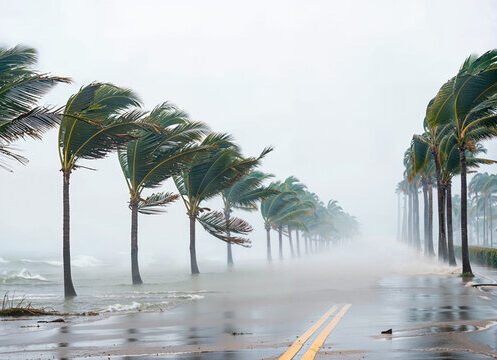It’s important to prepare for hurricane season in the Leesburg, FL area, and that includes protecting your HVAC system. Flying debris, heavy rain, power surges, and flooding can cause thousands of dollars in damage.
While it’s not always possible to prevent damage during a major storm, taking these precautions can help minimize the risk and reduce the likelihood of expensive post-storm repairs.
Keep the Surrounding Area Clear of Debris
Before hurricane season begins, inspect the area around your outdoor HVAC unit. Remove any dead branches, loose landscaping, or other debris that could become a projectile in high winds.
Trim any overhanging or damaged limbs from nearby trees, and dispose of yard waste rather than piling it nearby. If a storm is approaching, move patio furniture, trash cans, grills, and garden tools indoors or into the garage to prevent them from being blown into the HVAC unit, or your home.
Raise the Outdoor Unit If Possible
In many Florida homes, outdoor HVAC condensers are elevated to prevent flood damage from storm surges or heavy rainfall. If your unit sits directly on the ground, it’s a smart idea to speak with a licensed HVAC contractor or structural professional about raising it on a hurricane-rated platform.
This isn’t a DIY project—HVAC systems are heavy, and improperly lifting or moving the unit can damage refrigerant lines and internal components.
If raising the unit isn’t feasible, consider placing sandbags around it before a storm. Keep in mind that sandbags should only be used as a temporary emergency measure. They can help deflect water, but they shouldn’t be left in place long-term. Also, make sure to position them at least two to three feet away from the unit to maintain airflow. Placing them too close can cause the compressor to overheat and reduce system efficiency.
Shut Off Power to the HVAC System
As part of your final hurricane preparations, turn off the power to your HVAC system at both the indoor circuit breaker and the outdoor AC disconnect switch.
Hurricanes can bring lightning strikes and power surges from downed power lines or blown transformers. These surges can cause major damage to your AC’s electrical components. Shutting off power reduces that risk and also prevents the system from running if it becomes submerged or damaged during the storm.
Never turn your system back on until after the storm has completely passed, you’ve uncovered the outdoor unit, and visually inspected it for damage or flooding.
Cover and Secure the Outdoor Unit
Once the power is off, use a waterproof tarp or piece of plywood to cover the top of the outdoor unit, and secure it using hurricane-rated straps or tie-downs. This helps block debris from falling into the unit during the storm.
If you’re concerned about flying debris from all sides, you can also cut plywood to fit each side of the unit and secure it with additional straps. Just make sure all coverings are removed as soon as it’s safe to do so after the storm.
Never run your air conditioner while it’s covered. Doing so can block airflow, overheat the system, and lead to severe compressor damage.
Post-Storm HVAC Safety Steps
Once the storm has passed and it’s safe to go outside, remove the cover and inspect the outdoor unit carefully. Do not turn the system back on until you complete the following checks:
- Look for standing water or signs of flooding around the unit
- Inspect for visible damage, dislodged parts, or signs the unit shifted
- Check for debris inside or around the unit
- Make sure power lines or the AC disconnect weren’t damaged
- Confirm the unit was not submerged
If any flooding occurred, even just a few inches, you should not restart the system. Floodwater can corrode electrical parts and cause internal short circuits. Higher water levels (above 6–12 inches) are more likely to damage the compressor and other components.
If the unit looks shifted or tilted, it may have strained or disconnected refrigerant lines, which can cause leaks or pressure imbalances. Additionally, if your power went out during the storm, there’s a chance your HVAC was affected by a surge.
To be safe, have the unit professionally inspected before restarting it. Once cleared, restore power at both the disconnect switch and breaker. As you run the system, monitor it closely for unusual noises, circuit breaker trips, smoke, or weak airflow. If anything seems off, shut it down and call a licensed HVAC technician right away.
Consider Surge Protection
To further protect your HVAC system, we recommend installing a surge protector designed specifically for HVAC units or a whole-home surge protector. These devices help shield your system’s electronics from voltage spikes and can prevent costly repairs.
Your Expert HVAC Team in Leesburg
Since 2002, M&S Air Conditioning has been providing expert HVAC service throughout Leesburg and surrounding communities. We specialize in preventative maintenance and storm-readiness services to help protect your comfort year-round.
Whether you need help raising your outdoor unit, installing surge protection, or inspecting for post-storm damage, our licensed professionals are here to help.
Contact M&S Air Conditioning today to schedule service or get expert guidance on preparing your HVAC system for Florida’s hurricane season.



